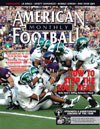AMERICAN FOOTBALL MONTHLY THE #1 RESOURCE FOR FOOTBALL COACHES
Article CategoriesAFM Magazine
|
Building Team Unity with the Games Inside the GameHow Oregon State\'s Jay Locey finds ways to make the game fun while bringing players togetherby: Mike Kuchar © More from this issue These days the game of football is broken down to a science. Sure, most coaches preach lip service about blocking and tackling but they are usually the same ones that spend a great deal of money and countless hours filing into clinic discussions trying to find the latest innovative offensive scheme or researching a bone-crushing defense. So instead of searching the ends of the earth for the newest scheme or end-all technicality, some coaches have turned towards the intangibles like developing team chemistry in order to separate their squad from the rest. While the X’s and O’s are still an essential part of the game, some coaches find that developing the mental, and not physical part of the game, gives them the advantage. Such was the case with former Linfield College (McMinnville, OR) head coach Jay Locey. It was early in the ....The full article can only be seen by subscribers. Subscribe today!
|
|
|||||||
| HOME |
MAGAZINE |
SUBSCRIBE | ONLINE COLUMNISTS | COACHING VIDEOS |
Copyright 2025, AmericanFootballMonthly.com
All Rights Reserved





